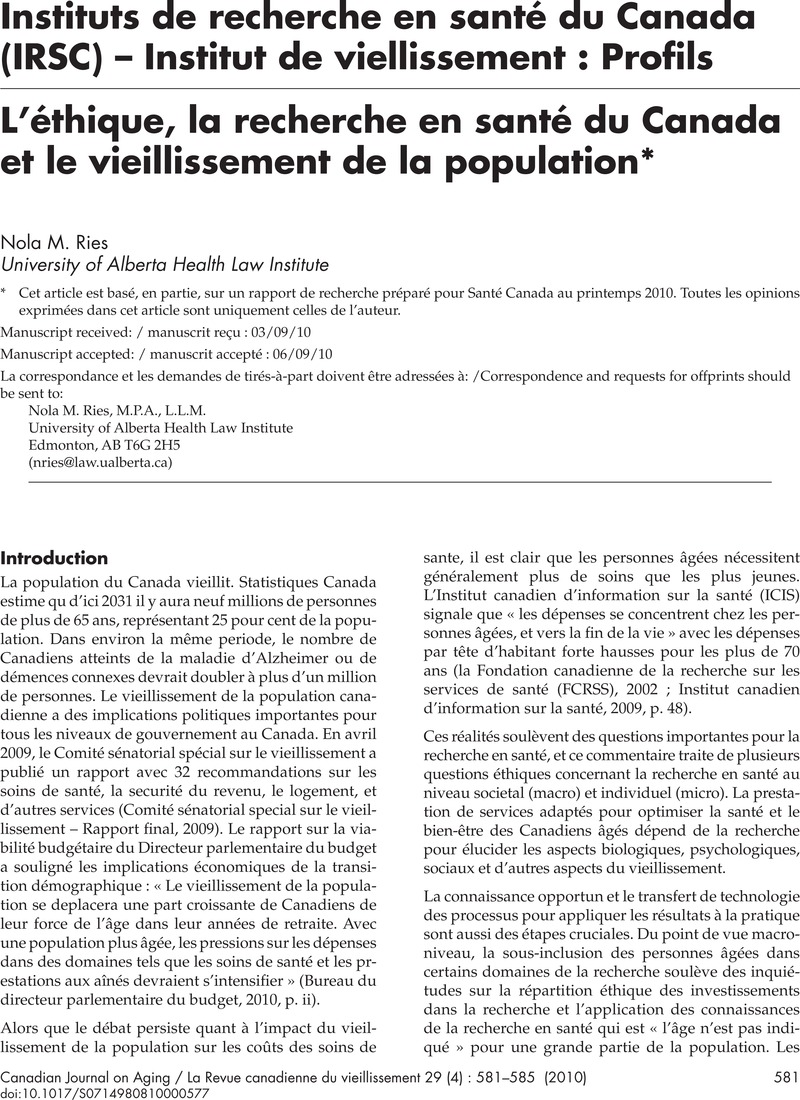No CrossRef data available.
Article contents
L’éthique, la recherche en santé du Canada et le vieillissement de la population*
Published online by Cambridge University Press: 07 December 2010
Abstract
An abstract is not available for this content so a preview has been provided. Please use the Get access link above for information on how to access this content.

- Type
- Canadian Institutes of Health Research–Institute of Aging: Profile/Instituts de recherche en santé du Canada (IRSC) – Institut du vieillissement : Profils
- Information
- Canadian Journal on Aging / La Revue canadienne du vieillissement , Volume 29 , Issue 4 , December 2010 , pp. 581 - 585
- Copyright
- Copyright © Canadian Association on Gerontology 2010
Footnotes
*
Cet article est basé, en partie, sur un rapport de recherche préparé pour Santé Canada au printemps 2010. Toutes les opinions exprimées dans cet article sont uniquement celles de l’auteur.
References
Références
Alzheimer Society of Canada. (2009). Rising tide: The impact of dementia on Canadian society. Retrieved September 16, 2010 from http://www.alzheimer.ca/english/rising_tide/rising_tide_report.htmGoogle Scholar
Bayer, A., et Tadd, W. (2000). Unjustified exclusion of elderly people from studies submitted to research ethics committee for approval: Descriptive study. British Medical Journal, 321, 992–993.CrossRefGoogle ScholarPubMed
Black, B.S., Rabins, P.V., Sugarman, J., et Karlawish, J.H. (2010). Seeking assent and respecting dissent in dementia research. American Journal of Geriatric Psychiatry, 18(1), 77–85.CrossRefGoogle ScholarPubMed
British Geriatrics Society. (2009). In response to a public consultation process conducted by the Nuffield Council on Bioethics, quoted in Dementia: Ethical issues. London: Nuffield Council on Bioethics. Retrieved September 16, 2010 from http://www.nuffieldbioethics.org/fileLibrary/pdf/Dementia_report_for_web.pdfGoogle Scholar
Bugeja, G., Kumar, A., et Banerjee, A.K. (1997). Exclusion of elderly people from clinical research: A descriptive study of published reports. British Medical Journal, 315, 1059. The study found that 170 out of 490 papers revealed unjustified exclusions of older people.CrossRefGoogle ScholarPubMed
Callahan, D. (1987). Setting limits: Medical goals in an aging society. New York: Simon and Schuster.Google Scholar
Canadian Health Services Research Foundation. (2002). Mythbusters—Myth: The aging population will overwhelm the healthcare system. Ottawa, Ontario, Canada: Canadian Health Services Research Foundation. Retrieved September 16, 2010 from http://www.chsrf.ca./mythbusters/pdf/myth5_e.pdfGoogle Scholar
Canadian Institute for Health Information. (2009). Health care in Canada 2009: A decade in review. Ottawa, Ontario, Canada: Canadian Institute for Health Information.Google Scholar
Daniels, N., & Sabin, J.E. (2008). Accountability for reasonableness: An update. British Medical Journal, 337, a1850.Google Scholar
Fleck, L.M. (2010). Just caring: In defense of limited age-based healthcare rationing. Cambridge Quarterly of Healthcare Ethics, 19, 27–37.CrossRefGoogle ScholarPubMed
Habitch, D.W., et McMurdo, M.E.T. (2008). The under-representation of older people in clinical trials: Barriers and potential solutions. Journal of Nutrition, Health and Aging, 12(3), 194–196.Google Scholar
Knapp, M., et Prince, M. (2007). Dementia UK. London: Alzheimer’s Society. The Nuffield Council on Bioethics report.Google Scholar
McMurdo, M. (2005). Including older people in clinical research. British Medical Journal, 331, 1036–1037.Google Scholar
Office of the Parliamentary Budget Officer. (2010). Fiscal sustainability report. Retrieved September 16, 2010 from http://www2.parl.gc.ca/Sites/PBO-DPB/documents/FSR_2010.pdfGoogle Scholar
Persad, G., Wertheimer, A., et Emanuel, E.J. (2009). Principles for allocation of scarce medical interventions. Lancet, 373, 423–431.Google Scholar
Pierce, R. (2010). A changing landscape for advance directives in dementia research. Social Science & Medicine, 70, 623–630.Google Scholar
Puts, M.T., Monette, J., Girre, V., Wolfson, C., Monette, M., Batist, G., et al. . (2009). Participation of older newly diagnosed cancer patients in an observational prospective pilot study: An example of recruitment and retention. BMC Cancer, 9, 277. doi:10.1186/1471-2407-9-277.CrossRefGoogle Scholar
Samelson, E.J., Kelsey, J.L., Kiel, D.P., Roman, A.M., Cupples, L.A., Freeman, M.B., et al. . (2008). Issues in conducting epidemiologic research among elders: Lessons from the MOBILIZE Boston study. American Journal of Epidemiology, 168(12), 1444–1451.Google Scholar
Senate, Special Senate Committee on Aging—Final Report. (2009). Canada’s aging population: Seizing the opportunity (The Honourable Sharon Carstairs, P.C., Chair, The Honourable Wilbert Joseph Keon, Deputy Chair). Retrieved September 16, 2010 from http://www.parl.gc.ca/40/2/parlbus/commbus/senate/com-e/agei-e/rep-e/AgingFinalReport-e.pdfGoogle Scholar
Scott, I.A., et Gyatt, G.H. (2010). Cautionary tales in the interpretation of clinical studies involving older persons. Archives of Internal Medicine, 170(7), 587–595.Google Scholar
van Spall, H.G.C., Toren, A., Kiss, A., et Fowler, R.A. (2007). Eligibility criteria of randomized controlled trials published in high-impact general medical journals. Journal of the American Medical Association, 297, 1233–1240.CrossRefGoogle ScholarPubMed


